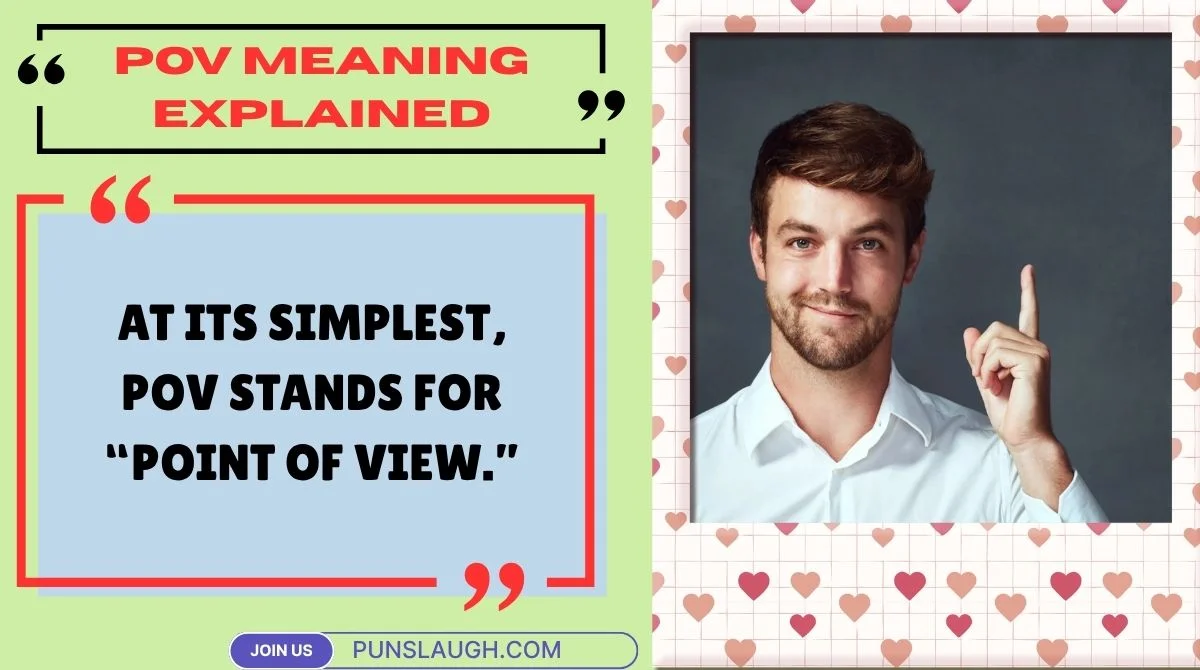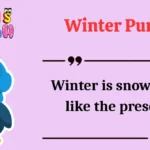Understanding what POV means has become more important than ever.
From TikTok trends to literature and gaming, this three-letter acronym shows up everywhere. But the meaning changes depending on where you see it.
In this guide, you’ll learn exactly what POV stands for, why it matters, and how it’s used across platforms and industries.
By the end, you’ll be able to recognize and use POV confidently in your texts, posts, or storytelling.
Introduction: Why “POV” Matters in Today’s Digital World
Scroll through TikTok, Instagram, or YouTube and you’ll often see “POV:” in captions. In books and films, POV defines the voice of the story. Even in gaming or medical notes, it holds a specific meaning.
This article dives deep into POV meaning in all these settings.
Understanding it is not just fun — it helps you interpret posts, join conversations, and communicate clearly.
“The point of view you choose can change how your story is told — whether in a novel, a video, or even a tweet.”
What Does POV Mean? (Core Definition)
At its simplest, POV stands for “Point of View.”
It refers to the perspective from which something is seen, told, or experienced.
Origins of POV
- Film & Photography: Early filmmakers used “POV shots” to show scenes as if through the character’s eyes.
- Literature: Authors have long discussed first-person and third-person points of view to shape storytelling.
- Digital Media: Social platforms adopted POV as a way to make content relatable and immersive.
Key Idea: POV isn’t fixed. Its meaning shifts with context — in a novel, it might describe the narrator’s voice, while in a meme, it sets up a joke.
POV Across Digital Platforms
Social media has reinvented POV.
It’s not just about storytelling — it’s about making the viewer feel inside the moment.
POV in Social Media Culture
POV content thrives online because it:
- Makes posts feel personal and immersive.
- Encourages interaction and relatability.
- Often delivers humor or drama in a fresh way.
Short-form videos (TikTok, Instagram Reels, YouTube Shorts) especially popularized POV trends.
POV on TikTok
TikTok deserves credit for making POV videos go viral.
How TikTok Uses POV:
- Storytelling skits: Creators act as if the viewer is part of the scene.
- Reaction POVs: You see their take on a trending moment.
- Memes & challenges: POV captions spark quick humor (#POVchallenge).
- Cinematic filters: Enhance the immersive feel.
Example:
“POV: You’re late for school and the teacher stares at you like this…”
TikTok’s POV trend transformed how people create relatable micro-stories online.
POV on Instagram
On Instagram, POV meaning often aligns with:
- Reels: Short scenes inviting you into a moment — like a friend’s reaction or a funny situation.
- Stories: Behind-the-scenes glimpses from the user’s own perspective.
- Captions: To add humor or dramatize a photo.
Creators often use POV to make content feel authentic and spontaneous.
POV on YouTube & Shorts
YouTube also embraces POV but in slightly different ways:
- Gaming videos: Especially first-person shooter (FPS) games.
- Vlogs: “POV: Walking through Times Square at night.”
- Educational videos: Explaining a concept as if speaking directly to the viewer.
YouTube’s long-form style lets creators mix POV with commentary, while Shorts use it for quick, punchy clips.
POV on Facebook & Snapchat
On Facebook and Snapchat, POV shows up in:
- Short clips and reactions shared with friends.
- Filters and lenses that mimic a first-person view.
- Stories or Snaps: Quick moments captured from the user’s own eyes.
Though not as trendy as TikTok, these platforms still keep POV content relevant.
POV in Everyday Digital Communication
POV in Chat and Text Messages
In texting, people use POV informally to share perspectives or emotions.
Examples in Text:
- “POV: You forgot your best friend’s birthday.”
- “POV when the Wi-Fi drops during an online exam.”
It works as a shorthand setup for scenarios, often for humor or drama.
POV in Slang & Pop Culture
Online slang reshaped POV into a meme-friendly tool.
Common Uses:
- Sarcasm or irony: “POV: You think you’ll study but end up scrolling TikTok.”
- Relatable moments: Turning daily life situations into quick jokes.
- Pop culture: Fans write POV captions to describe a character’s perspective in shows or movies.
Urban Dictionary & Internet Culture
Urban Dictionary often reflects the informal, evolving nature of POV.
- Lists meme-style definitions.
- Captures how young users reshape traditional meanings.
- Helps track cultural shifts in slang.
POV in Professional and Niche Contexts
POV isn’t just for memes or social posts. It plays a serious role in professional fields.
POV in Literature and Storytelling
In writing, POV determines who tells the story.
| POV Type | Description | Example Sentence |
|---|---|---|
| First-Person | Narrator is a character in the story | “I opened the old wooden door.” |
| Second-Person | Narrator addresses the reader directly | “You step into a dark hallway.” |
| Third-Person | Narrator is outside the story | “He watched the door creak open.” |
Pro Tip: The chosen POV influences how readers connect emotionally with the story.
POV in Film & Photography
Directors often use POV shots to immerse viewers:
- Horror films use it to build suspense.
- Action scenes use it to place you in the hero’s shoes.
- Photography uses POV angles to simulate human perspective.
POV in the Medical Field
In healthcare:
- POV often means the patient’s perspective — crucial for patient-centered care.
- Clinicians use the term to highlight experiences or viewpoints that affect treatment.
- Therapists explore POV to understand emotions and behavior.
POV in Vehicles, Tech & Gaming
POV is common in tech-related contexts:
- Dashcams: Record the driver’s point of view.
- Drones: Offer aerial POV shots.
- VR & AR: Entirely based on first-person perspectives.
- Gaming: FPS vs. third-person view defines the entire play experience.
POV in Adult Content (Sensitive but Relevant)
In adult media, POV refers to first-person filmed experiences.
It’s a widely recognized category and highlights why context is critical — the same acronym carries very different meanings across platforms.
Real-World Examples of POV
Here are some practical examples to clarify the use of POV:
| Context | Example Sentence or Caption |
|---|---|
| TikTok | “POV: You’re at your best friend’s wedding.” |
| Chat Text | “POV when your boss calls on your day off.” |
| Gaming | “POV: Sniping from a rooftop in the game.” |
| Literature | “POV: I never thought I’d survive the storm.” |
| Marketing | “POV: You’re opening our new product for the first time.” |
Common Misunderstandings & Pitfalls
Even though it’s simple, people often misinterpret POV.
Common Mistakes:
- Thinking POV always means opinion rather than perspective.
- Confusing POV in memes with formal storytelling POV.
- Forgetting context: a POV TikTok caption ≠ POV in a novel.
Tip: Always ask — whose eyes or perspective am I experiencing this from?
FAQs on POV Meaning
What does POV stand for in texting?
POV stands for Point of View, often used in texts to set up a scenario or emotion.
Is POV the same on TikTok and in literature?
No. On TikTok, it’s about immersive short videos, while in literature, it refers to the narrator’s voice and perspective.
How do I write or create content in POV style?
Think about whose eyes or voice the audience experiences the story through — then write or record from that perspective.
What’s the difference between POV and perspective?
Perspective is broader — it includes opinions and attitudes.
POV is specifically the angle or lens through which the audience experiences the scene or story.
Why is POV important in digital communication?
It shapes how the audience feels involved.
From memes to marketing, POV builds relatability and engagement.
Key Takeaways & Final Thoughts
POV means Point of View, but its use varies:
- In social media: It creates relatable, immersive posts.
- In storytelling: It defines the narrator’s voice.
- In professional fields: It ensures empathy and clarity.
Understanding POV meaning helps you decode trends, improve your content, and connect better with your audience.
As technology evolves — from TikTok to VR — expect POV to remain central in how stories are told.





